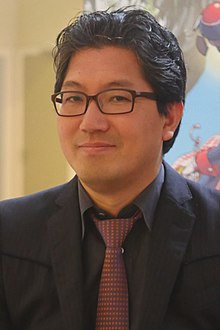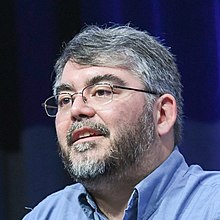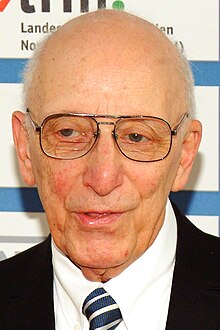Portal:Video games
The Video Games Portal

A video game, also known as a computer game or just a game, is an electronic game that involves interaction with a user interface or input device (such as a joystick, controller, keyboard, or motion sensing device) to generate visual feedback from a display device, most commonly shown in a video format on a television set, computer monitor, flat-panel display or touchscreen on handheld devices, or a virtual reality headset. Most modern video games are audiovisual, with audio complement delivered through speakers or headphones, and sometimes also with other types of sensory feedback (e.g., haptic technology that provides tactile sensations). Some video games also allow microphone and webcam inputs for in-game chatting and livestreaming.
Video games are typically categorized according to their hardware platform, which traditionally includes arcade video games, console games, and computer (PC) games; the latter also encompasses LAN games, online games, and browser games. More recently, the video game industry has expanded onto mobile gaming through mobile devices (such as smartphones and tablet computers), virtual and augmented reality systems, and remote cloud gaming. Video games are also classified into a wide range of genres based on their style of gameplay and target audience. (Full article...)
Featured articles –
The Miller brothers had started in game development creating black-and-white, largely plotless works aimed at children. They wanted Myst to be a graphically impressive game with a nonlinear story and mystery elements aimed at adults. The game's design was limited by the small memory footprint of video game consoles and by the slow speed of CD-ROM drives. The game was created on Apple Macintosh computers and ran on the HyperCard software stack, though ports to other platforms subsequently required the creation of a new engine.
Myst was a critical and commercial success. Critics lauded the ability of the game to immerse players in its fictional worlds. It has been called one of the most influential and best video games ever made. Selling more than six million copies, Myst was the best-selling PC game for nearly a decade. The game helped drive adoption of the CD-ROM drive, spawned a multimedia franchise, and inspired clones, parodies, and new video game genres, as well as spin-off novels and other media. The game has been ported to multiple platforms and remade multiple times. (Full article...)
Namco Limited was a Japanese multinational video game and entertainment company founded in 1955 which operated video arcades and amusement parks globally, produced video games, films, toys, and arcade cabinets. They were one of the most influential figures in the worldwide coin-op and arcade game industry; Namco produced several multi-million-selling game franchises, such as Pac-Man, Galaxian, Tekken, Tales, Ridge Racer, and Ace Combat. In 2006, Namco merged with Bandai to form what is now named Bandai Namco Holdings; the standalone Namco brand continues to be used for video arcade and other entertainment products by the group's Bandai Namco Amusements division.
The Namco name comes from Nakamura Manufacturing Company, derived from its founder Masaya Nakamura. In the 1960s, it manufactured electro-mechanical arcade games such as the 1965 hit Periscope. It entered the video game industry after acquiring the struggling Japanese division of Atari in 1974, distributing games such as Breakout in Japan. The company renamed itself Namco in 1977 and published Gee Bee, its first original video game, a year later. Among Namco's first major hits was the fixed shooter Galaxian in 1979. It was followed by Pac-Man in 1980. Namco prospered during the golden age of arcade video games in the early 1980s, releasing popular titles such as Galaga, Xevious, and Pole Position.
Namco entered the home market in 1984 with conversions of its arcade games for the MSX and the Nintendo Family Computer, later expanding to competing platforms, such as the Sega Genesis, TurboGrafx-16, and PlayStation. Namco continued to produce hit games in the 1990s, including Ridge Racer, Tekken, and Taiko no Tatsujin, but later endured financial difficulties due to the struggling Japanese economy and diminishing arcade market. This led to the 2005 announcement of a merge with toy maker Bandai, which was completed in 2006 as Namco Bandai Holdings; Namco's former video games division was merged into a subsidiary of the holdings company, Namco Bandai Games, now called Bandai Namco Entertainment. Namco is remembered in retrospect for its unique corporate model, its importance to the industry, and its advancements in technology. (Full article...)
Set in the fantasy world of Spira, a setting influenced by the South Pacific, Thailand and Japan, the game's story revolves around a group of adventurers and their quest to defeat a rampaging monster known as Sin. The player character is Tidus, a star athlete in the fictional sport of blitzball, who finds himself in Spira after Sin attacked his home city of Zanarkand. Shortly after arriving to Spira, Tidus becomes a guardian to summoner Yuna to destroy Sin upon learning its true identity is that of his missing father, Jecht.
Development of Final Fantasy X began in 1999, with a budget of more than $32.3 million ($59.1 million in 2023 dollars) and a team of more than 100 people. The game was the first in the main series not entirely scored by Nobuo Uematsu; Masashi Hamauzu and Junya Nakano were signed as Uematsu's fellow composers. Final Fantasy X was both a critical and commercial success, shipping over 8.5 million units worldwide on PlayStation 2. It is considered to be one of the greatest video games ever made. It was followed by Final Fantasy X-2 in March 2003, making it the first Final Fantasy game to have a direct game sequel. As of September 2021, the Final Fantasy X series had sold over 20.8 million units worldwide, and at the end of March 2022 had surpassed 21.1 million. (Full article...)

Age of Empires is a series of historical real-time strategy video games, originally developed by Ensemble Studios and published by Xbox Game Studios. The first game was Age of Empires, released in 1997. Nine total games within the series have been released so far as of October 28, 2021.
Age of Empires focused on events in Europe, Africa and Asia, spanning from the Stone Age to the Iron Age; the expansion game explored the formation and expansion of the Roman Empire. The sequel, Age of Empires II: The Age of Kings, was set in the Middle Ages, while its expansion focused partially on the Spanish conquest of the Aztec Empire. The subsequent three games of Age of Empires III explored the early modern period, when Europe was colonizing the Americas and several Asian nations were on the decline. Another installment, Age of Empires Online, takes a different approach as a free-to-play online game utilizing Games for Windows Live. A spin-off game, Age of Mythology, was set in the same period as the original Age of Empires, but focused on mythological elements of Greek, Egyptian, and Norse mythology. The fourth main installment in the series, Age of Empires IV, was released on October 28, 2021, also focusing on the Middle Ages.
The Age of Empires series has been a commercial success, selling over 25 million copies. Critics have credited part of the success of the series to its historical theme and fair play; the artificial intelligence (AI) players have fewer advantages than in many of the series' competitors. (Full article...)
The six main playable characters in Final Fantasy VIII are Squall Leonhart, a loner who avoids vulnerability by focusing on his duty; Rinoa Heartilly, an outspoken and passionate young woman who follows her heart; Quistis Trepe, an instructor with a serious yet patient attitude; Zell Dincht, an energetic martial artist with a fondness for hot dogs; Selphie Tilmitt, a cheerful girl who loves trains and flies the airship Ragnarok; and Irvine Kinneas, a marksman and womanizer who uses his charm to mask his insecurities. Temporarily playable characters include Laguna Loire, Kiros Seagill, and Ward Zabac, who appear in "flashback" sequences; SeeD cadet-turned-antagonist Seifer Almasy; and sorceress Edea Kramer. The main antagonist is Ultimecia, a sorceress from the future who wishes to compress time. (Full article...)
Like the previous installment, Sinistar: Unleashed focuses on the destruction of the Sinistar, a large bio-mechanical machine, powered by machines called the Sporg. To achieve this goal, the player has a variety of starships, power-ups and weapons. Unlike its predecessor, the game has full three-dimensional graphics and a wider control scheme. Sinistar: Unleashed features 29 levels, five of which are hidden; each level has a Sinistar.
Sinistar: Unleashed received mixed reception when released. Critics lauded its audacity, as well as the addition of new features into the game. Several journalists felt that GameFX captured all the elements that represented a Sinistar game and stayed true to the franchise by feeling familiar to fans of the original game. However, critics faulted the boss designs and the repetitiveness of the gameplay. (Full article...)
Thief II was designed to build on the foundation of its predecessor. In response to feedback from players of Thief, the team placed a heavy focus on urban stealth in the sequel, and they minimized the use of monsters and maze-like levels. The game was made with the third iteration of the Dark Engine, which had been used previously to develop Thief and System Shock 2. Thief II was announced at the 1999 Electronic Entertainment Expo, as part of an extended contract between Looking Glass and Eidos to release games in the Thief series. Looking Glass neared bankruptcy as the game was developed, and the company was kept running by advances from Eidos.
Thief II received positive reviews from critics, and its initial sales were stronger than those of its predecessor. However, the game's royalties were processed slowly, which compounded Looking Glass's financial troubles. As a result, the company closed in May 2000, with plans for Thief III cancelled. The third game in the series, entitled Thief: Deadly Shadows, was developed by Ion Storm and published by Eidos in 2004. Thief 2X: Shadows of the Metal Age, a widely praised expansion mod for Thief II, was released in 2005. In 2014, Square Enix published a reboot of the series, developed by Eidos Montréal. (Full article...)
Set in the fictional Star Wars galaxy, the game takes place during the events depicted in the film Star Wars: Episode I – The Phantom Menace. The player controls Gavyn Sykes, a lieutenant in Naboo's Royal Security Forces. As the game progresses, Sykes and the Royal Security Forces fight the Trade Federation in 15 missions that take place on Naboo or in the space surrounding it. The game concludes after the player completes a mission that recreates the film's climactic assault on the Trade Federation's Droid Control Ship.
Battle for Naboo was published by LucasArts and THQ and released for the Nintendo 64 in December 2000. A Windows port was released three months later in March 2001. The Nintendo 64 version was heavily compared to Rogue Squadron and received generally positive reviews; critics praised the game's tight and responsive controls, but expressed dislike for the game's Episode I setting. The game's PC port was less well-received, with critics citing poor visuals and difficult controls. (Full article...)
The number of playable characters in Brawl has grown from that in Super Smash Bros. Melee, although some characters from Melee were cut in the game. Brawl is the first game in the series to have playable third-party characters. Like that of its predecessors, the objective of Brawl is to knock opponents off the screen. It is a departure from traditional fighting games, notably in its simplified move commands and emphasis on ring outs over knockouts. It includes a more extensive single-player mode than its predecessors, known as the Subspace Emissary. This mode is a plot-driven, side-scrolling beat 'em up featuring computer-generated cutscenes. Brawl supports multiplayer battles with up to four combatants, and is the first game of its franchise to feature online battles via Nintendo Wi-Fi Connection. The game is unique in that it can be played with four different controllers, including the Wii Remote, Wii Remote with Nunchuk, GameCube controller, and Classic Controller, simultaneously.
Super Smash Bros. Brawl received universal acclaim, with praise centered on its entertainment value despite issues relating to its content loading times. Its musical score, composed through a collaboration of 38 renowned video game composers, was lauded for its representation of different generations in gaming history. Brawl was named the "Fighting Game of the Year" by the Academy of Interactive Arts & Sciences. In 2010, the game was included as one of the titles in the book 1001 Video Games You Must Play Before You Die, and is also considered to be one of the best video games ever made. As of 2023[update], it is the eighth best-selling Wii game of all time, with over thirteen million copies sold worldwide. It was followed by Super Smash Bros. for Nintendo 3DS and Wii U in 2014. (Full article...)
Did you know... -
- ... that a version of the video game Rhino Rumble was not released due to the creators not wanting to add licensed characters?
- ... that development on the video game Expeditions: Rome was not affected by lockdowns from the COVID-19 pandemic because the developer was already split between Copenhagen and Istanbul?
- ... that the 1987 video game Oriental Hero was panned as "so incredibly bad it's almost worth a look"?
- ... that Terra Invicta's development company is a group of former volunteer video game modders that decided to release their own game after the success of their mod?
- ... that Rockstar Vienna was the largest video game developer in Austria when it closed in 2006?
- ... that the Chicago Sun-Times credits JumpStart Toddlers as the first video game targeted towards babies?
- ... that the album series Jingle Cats spawned Jingle Dogs, Jingle Babies, and a Japanese video game in which "the object is to breed and care for cats, which begin to sing when they're done copulating"?
- ... that after becoming paralyzed from the neck down, Rocky "RockyNoHands" Stoutenburgh broke two Guinness World Records in the video game Fortnite?
- ... that Through the Darkest of Times was the first video game published in Germany to use swastikas?
- ... that Kamibox's video game A Joke That's Worth $0.99 is permanently on special offer because Itch.io does not allow $0.99 as a regular price?
- ... that approximately 85 percent of Manhattan was recreated for the 2008 video game The Incredible Hulk?
- ... that the 2014 text adventure The Uncle Who Works for Nintendo is inspired by a source cited by children for spreading video game rumors?
Selected biography –
Selected image -
Recent video game-related events
- September 12, 2024 – 2023–2024 video game industry layoffs
- Microsoft announces that it will lay off 650 Microsoft Gaming employees as part of cuts to its workforce. (Variety)
- August 15, 2024 –
- American video game magazine Game Informer discontinues publication after 33 years. The magazine's website is also shut down. (BBC News)
- May 24, 2024 – Uvalde school shooting
- Families in Uvalde, Texas, U.S., file a lawsuit against Daniel Defense and Activision Blizzard for creating the DDM4 V7 gun and promoting the weapon through the game Call of Duty, respectively. They also sue Meta Platforms for owning Instagram, which was used by the gunman. (AP)
Topics
Categories
Things you can do
In other Wikimedia projects
The following Wikimedia Foundation sister projects provide more on this subject:
-
Commons
Free media repository -
Wikibooks
Free textbooks and manuals -
Wikidata
Free knowledge base -
Wikinews
Free-content news -
Wikiquote
Collection of quotations -
Wikisource
Free-content library -
Wikiversity
Free learning tools -
Wiktionary
Dictionary and thesaurus















































